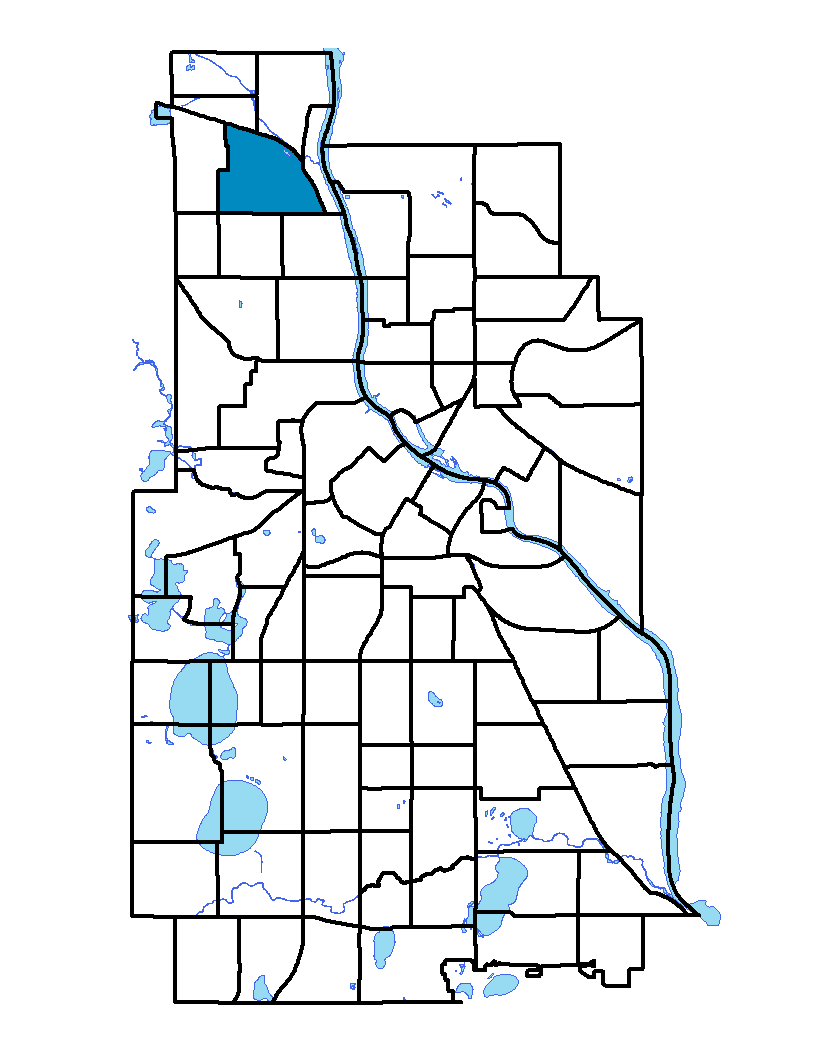Located in northwest Minneapolis, the Webber-Camden neighborhood gets its name from Webber Park and Webber Parkway, which were both named after Charles C. Webber, who donated a portion of the land for the park. Webber-Camden was also named after Camden, New Jersey. In March 1995 the City Planning Commission approved a change to the neighborhood's northern boundary from Webber Parkway to the railroad tracks, beginning at Highway 52, and then south on 45 th Avenue back to Webber Parkway. The changes did not affect any residential or commercial buildings and did not affect the data used in this report. Today Webber-Camden extends from Interstate 94 on the north. In 1995 the neighborhood added "Webber" to the original name "Camden," changing the name to "Webber-Camden." The neighborhood has industrial zones and a mix of middle-class and working-class homes. Webber Park connects to the Mississippi River, perhaps the area's most prominent feature, to the east.
To learn more about the neighborhood association visit: www.webbercamden.org
Indicator Details
| Indicators |
Primary Domain |
Indicator Value | Rank | Tier |
|---|---|---|---|---|
| Business Retention | Economic Health | 1.2% | 49 | Middle |
| Access to Mainstream Financial Services | Economic Health | 34.6% | 64 | Bottom |
| Local Business Vitality | Economic Health | 58.5% | 27 | Top |
| Reading Proficiency | Educational Opportunities | -% | - | Data N/A |
| Adult Educational Attainment | Educational Opportunities | 79.7% | 70 | Bottom |
| High School Graduation Rate | Educational Opportunities | 78.0% | 2 | Top |
| School Readiness Scores | Educational Opportunities | -% | - | Data N/A |
| Preschool Enrollment | Educational Opportunities | 39.7% | 57 | Middle |
| Residential Proximity to Traffic | Environmental Hazards | 13.3% | 50 | Middle |
| Proximity to Brownfield Sites | Environmental Hazards | 0.0% | 1 | Top |
| School Proximity to Traffic | Environmental Hazards | 0.0% | 1 | Top |
| Proximity to Superfund Sites | Environmental Hazards | 0.0% | 1 | Top |
| Toxic Releases from Facilities | Environmental Hazards | 21.1% | 55 | Middle |
| Public Assisted Households | Employment Opportunities | 68.4% | 78 | Bottom |
| Employment Rate | Employment Opportunities | 53.3% | 75 | Bottom |
| Long-Term Unemployment | Employment Opportunities | 10.4% | 81 | Bottom |
| Travel Time to Work | Employment Opportunities | 21.9 minutes | 37 | Middle |
| Vacancy Rates | Housing | 13.2% | 74 | Bottom |
| Age of Housing | Housing | 94.6% | 69 | Bottom |
| Blood Lead Levels in Children | Housing | 5.8% | 58 | Middle |
| Excessive Housing Cost Burden | Housing | 34.4% | 59 | Bottom |
| Violent Crime | Health Systems and Public Safety | 75.1 | 69 | Bottom |
| Chronic School Absence | Health Systems and Public Safety | 42.2% | 23 | Top |
| Low Birth Weight | Health Systems and Public Safety | 12.3% | 72 | Bottom |
| Motor Vehicle Collisions | Health Systems and Public Safety | 20 | 66 | Bottom |
| Preventable Hospitalizations | Health Systems and Public Safety | 9.2 | 73 | Bottom |
| Tree Cover | Natural Areas | 25.8% | 69 | Bottom |
| Access to Parks and Open Space | Natural Areas | 5.9% | 42 | Middle |
| Walkability | Neighborhood Characteristics | 45 | 70 | Bottom |
| Offsite Alcohol Outlets | Neighborhood Characteristics | 1 | 6 | Top |
| Food Desert | Neighborhood Characteristics | 100.0% | 31 | Middle |
| Residential Mobility | Social Cohesion | 77.6% | 50 | Middle |
| Voter Participation | Social Cohesion | 18.4% | 63 | Bottom |
| Transit Accessibility | Transportation | 293.4 | 44 | Middle |
| Commute Mode Share | Transportation | 31.5% | 39 | Middle |
| Household Transportation Costs | Transportation | 18.2% | 56 | Middle |
| Pedestrian Connectivity | Transportation | 135.1 | 38 | Middle |

